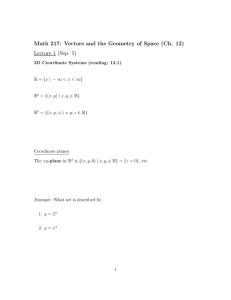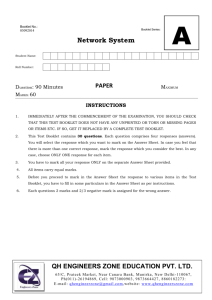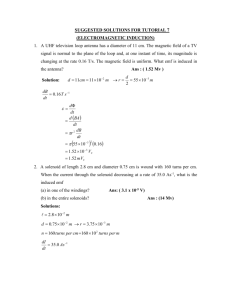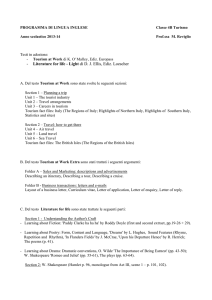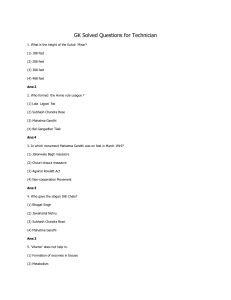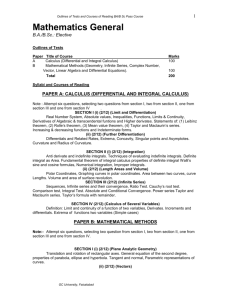Chapter 3: VECTORS
advertisement
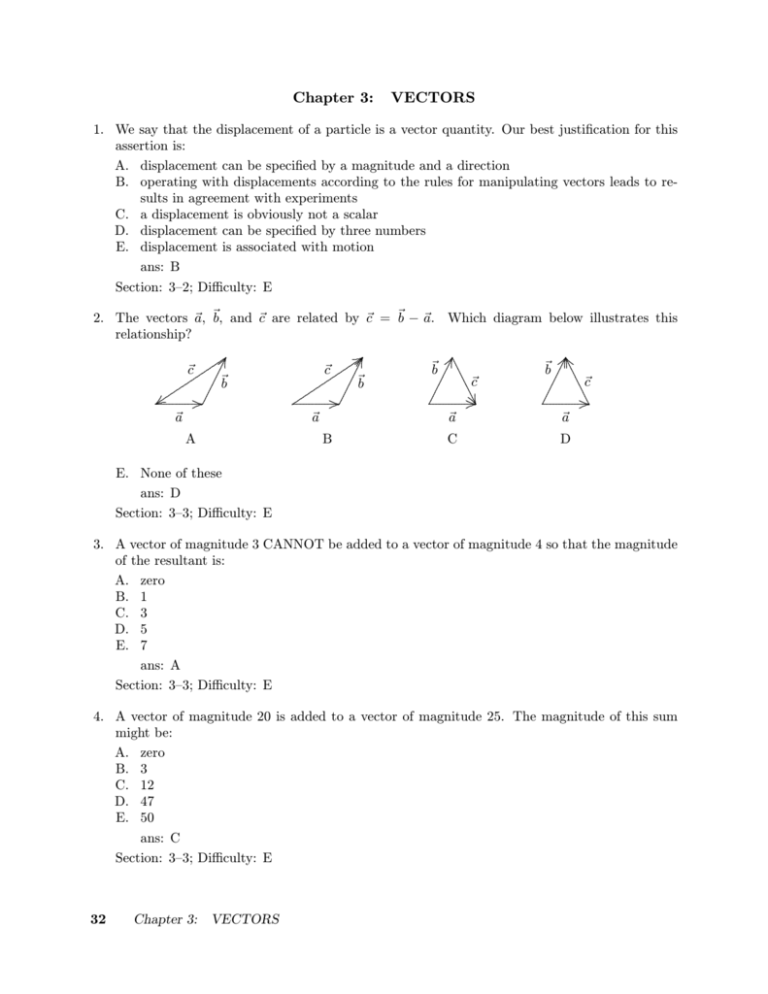
Chapter 3:
VECTORS
1. We say that the displacement of a particle is a vector quantity. Our best justi¯cation for this
assertion is:
A. displacement can be speci¯ed by a magnitude and a direction
B. operating with displacements according to the rules for manipulating vectors leads to results in agreement with experiments
C. a displacement is obviously not a scalar
D. displacement can be speci¯ed by three numbers
E. displacement is associated with motion
ans: B
Section: 3{2; Di±culty: E
2. The vectors ~a, ~b, and ~c are related by ~c = ~b ¡ ~a. Which diagram below illustrates this
relationship?
.....
.............
..............
~c.................................. .
....
.
.
.
.
.
... ~
...
... b
......
..
......
..
. .....
..........
.. ...
.......................................................................
..
~a
...........................
..
...............
~c.................................. .
....
.
.
.
.
... ~
.
...
... b
......
..
......
..
......
......
.. ...
................................................................
..
~a
A
B
....
............
~b ................ ..........
...
...
......
.................
~c
~b .................................
...
...
~c
...
.
...
...
...
...
..
...
. .....
..
.
.
............
..............................................................
..
...
...
...
..
...
...
...
...
.
..
.
.. ...
...........................................................
..
~a
~a
C
D
E. None of these
ans: D
Section: 3{3; Di±culty: E
3. A vector of magnitude 3 CANNOT be added to a vector of magnitude 4 so that the magnitude
of the resultant is:
A. zero
B. 1
C. 3
D. 5
E. 7
ans: A
Section: 3{3; Di±culty: E
4. A vector of magnitude 20 is added to a vector of magnitude 25. The magnitude of this sum
might be:
A. zero
B. 3
C. 12
D. 47
E. 50
ans: C
Section: 3{3; Di±culty: E
32
Chapter 3: VECTORS
~ of magnitude 6 and another vector T~ have a sum of magnitude 12. The vector T~ :
5. A vector S
A. must have a magnitude of at least 6 but no more than 18
B. may have a magnitude of 20
C. cannot have a magnitude greater than 12
~
D. must be perpendicular to S
E. must be perpendicular to the vector sum
ans: A
Section: 3{3; Di±culty: E
~ is:
6. The vector ¡A
~ in magnitude
A. greater than A
~ in magnitude
B. less than A
~
C. in the same direction as A
~
D. in the direction opposite to A
~
E. perpendicular to A
ans: D
Section: 3{3; Di±culty: E
~3 in the diagram is equal to:
7. The vector V
... ..
....................
.. ..........
......
..
......
..
......
...... ~
.
~2 ..
......V3
V
........
..
..
..
... ......
..
......
.
..
...
......
µ
....
....
..
...
..............................................................................................................
~1
V
~1 ¡ V
~2
A. V
~1 + V
~2
B. V
~1
~
C. V2 ¡ V
~
D. V1 cos µ
~1 =(cos µ)
E. V
Section: 3{3; Di±culty: E
ans: C
~ + Bj
~ 2 = A2 + B 2 , then:
8. If jA
~ and B
~ must be parallel and in the same direction
A. A
~
~ must be parallel and in opposite directions
B. A and B
~ or B
~ must be zero
C. either A
~ and B
~ must be 60±
D. the angle between A
E. none of the above is true
ans: E
Section: 3{3; Di±culty: M
Chapter 3: VECTORS
33
~ + Bj
~ = A + B and neither A
~ nor B
~ vanish, then:
9. If jA
~ and B
~ are parallel and in the same direction
A. A
~
~ are parallel and in opposite directions
B. A and B
~ and B
~ is 45±
C. the angle between A
~ and B
~ is 60±
D. the angle between A
~ is perpendicular to B
~
E. A
ans: A
Section: 3{3; Di±culty: E
~ ¡ Bj
~ = A + B and neither A
~ nor B
~ vanish, then:
10. If jA
~ and B
~ are parallel and in the same direction
A. A
~ and B
~ are parallel and in opposite directions
B. A
~ and B
~ is 45±
C. the angle between A
~
~
D. the angle between A and B is 60±
~ is perpendicular to B
~
E. A
ans: B
Section: 3{3; Di±culty: E
~ B,
~ C,
~ D)
~ all have the same magnitude. The angle µ between adjacent vectors
11. Four vectors (A,
±
is 45 as shown. The correct vector equation is:
....
...... ~
..... B
.
~ .....
.
.
A
.
..
....
.. ± ........
.
.......45
.. .......................
...... ....... .45±
....................................................................... C
~
............ 45±
.....
.....
.....
.....
......
........ ~
D
~¡B
~ ¡C
~
~
A
p+ D = 0
~
~
~
B + D ¡ 2C = 0
~+B
~ =B
~ +D
~
A
~
~
~
~
A+B+C
p+ D = 0
~ + C)=
~
~
(A
2 = ¡B
ans: B
Section: 3{3; Di±culty: H
A.
B.
C.
D.
E.
~ and B
~ lie in the xy plane. We can deduce that A
~=B
~ if:
12. Vectors A
A. A2x + A2y = Bx2 + By2
B. Ax + Ay = Bx + By
C. Ax = Bx and Ay = By
D. Ay =Ax = By =Bx
E. Ax = Ay and Bx = By
ans: C
Section: 3{3; Di±culty: E
34
Chapter 3: VECTORS
13. A vector has a magnitude of 12. When its tail is at the origin it lies between the positive x
axis and the negative y axis and makes an angle of 30± with the x axis. Its y component is:
p
A. 6= p3
B. ¡6 3
C. 6
D. ¡6
E. 12
ans: D
Section: 3{4; Di±culty: E
~ in the xy plane, is half as large as the magnitude of the
14. If the x component of a vector A,
vector, the tangent of the angle between the vector and the x axis is:
p
A.
3
B. p
1=2
C.
3=2
D. 3=2
E. 3
ans: D
Section: 3{4; Di±culty: M
~ = (6 m) ^i ¡ (8 m) ^j then 4A
~ has magnitude:
15. If A
A. 10 m
B. 20 m
C. 30 m
D. 40 m
E. 50 m
ans: D
Section: 3{4; Di±culty: E
16. A vector has a component of 10 m in the +x direction, a component of 10 m in the +y direction,
and a component of 5 m in the +z direction. The magnitude of this vector is:
A. zero
B. 15 m
C. 20 m
D. 25 m
E. 225 m
ans: B
Section: 3{4; Di±culty: E
Chapter 3: VECTORS
35
^ The magnitude of V
~ = (2:00 m) ^i + (6:00 m) ^j ¡ (3:00 m) k.
~ is:
V
5:00 m
5:57 m
7:00 m
7:42 m
8:54 m
ans: C
Section: 3{4; Di±culty: E
17. Let
A.
B.
C.
D.
E.
18. A vector in the xy plane has a magnitude of 25 m and an x component of 12 m. The angle it
makes with the positive x axis is:
A. 26±
B. 29±
C. 61±
D. 64±
E. 241±
ans: C
Section: 3{4; Di±culty: E
~ = (25 m) ^i + (45 m) ^j and the positive x axis is:
19. The angle between A
A. 29±
B. 61±
C. 151±
D. 209±
E. 241±
ans: B
Section: 3{4, 5; Di±culty: M
~ = (¡25 m) ^i + (45 m) ^j and the positive x axis is:
20. The angle between A
A. 29±
B. 61±
C. 119±
D. 151±
E. 209±
ans: C
Section: 3{4, 5; Di±culty: M
^ and B
^ The vector sum S
~ = (2 m) ^i+(6 m) ^j¡ (3 m) k
~ = (4 m) ^i+ (2 m) ^j+(1 m) k.
~ = A+
~ B
~
21. Let A
is:
^
A. (6 m) ^i + (8 m) ^j ¡ (2 m) k
^
^
^
B. (¡2 m) i + (4 m) j ¡ (4 m) k
^
C. (2 m) ^i ¡ (4 m) ^j + (4 m) k
^
^
^
D. (8 m) i + (12 m) j ¡ (3 m) k
E. none of these
ans: A
Section: 3{6; Di±culty: E
36
Chapter 3: VECTORS
^ and B
^ The vector di®erence
~ = (2 m) ^i + (6 m) ^j ¡ (3 m) k
~ = (4 m) ^i + (2 m ^j + (1 m) k.
22. Let A
~ =A
~¡B
~ is:
D
^
A. (6 m) ^i + (8 m) ^j ¡ (2 m) k
^
B. (¡2 m) ^i + (4 m) ^j ¡ (4 m) k
^
C. (2 m) ^i ¡ (4 m) ^j + (4 m) k
^
D. (8 m) ^i + (12 m) ^j ¡ (3 m) k
E. none of these
ans: B
Section: 3{6; Di±culty: E
~ = (2 m) ^i ¡ (3 m) ^j and B
~ = (1 m) ^i ¡ (2 m) ^j, then A
~ ¡ 2B
~ =
23. If A
A. (1 m) ^j
B. (¡1 m) ^j
C. (4 m) ^i ¡ (7 m) ^j
D. (4 m) ^i + (1 m) ^j
E. (¡4 m) ^i + (7 m) ^j
ans: A
Section: 3{6; Di±culty: E
~ has magnitude 12 m and B
~ has magnitude 8 m. The x component of A
~ +B
~
24. In the diagram, A
is about:
y
......... ....
~ ........... ..... .......... 60±
A
.........
...
...
.....
.
...
.
.
.
.
.
...
...
.
...
.
.
.
.
.
...
..
.
.
.
.
.......... B
..
~
.
.....
.
.
±
...
.
.
.
... 45
.
.
.
.
.... ...
x
A.
B.
C.
D.
E.
5:5 m
7:6 m
12 m
14 m
15 m
ans: C
Section: 3{6; Di±culty: M
25. A certain vector in the xy plane has an x component of 4 m and a y component of 10 m. It is
then rotated in the xy plane so its x component is doubled. Its new y component is about:
A. 20 m
B. 7:2 m
C. 5:0 m
D. 4:5 m
E. 2:2 m
ans: B
Section: 3{7; Di±culty: M
Chapter 3: VECTORS
37
~ and B
~ each have magnitude L. When drawn with their tails at the same point, the
26. Vectors A
~ ¢B
~ is:
angle between them is 30± . The value of A
A. zero
B. p
L2
C.
3L2 =2
D. 2L2
E. none of these
ans: C
Section: 3{8; Di±culty: E
^ and B
^ Then A
~ = (2 m) ^i + (6 m) ^j ¡ (3 m) k
~ = (4 m) ^i + (2 m) ^j + (1 m) k.
~¢B
~ =
27. Let A
^
A. (8 m) ^i + (12 m) ^j ¡ (3 m) k
^
B. (12 m) ^i ¡ (14 m) ^j ¡ (20 m) k
2
C. 23 m
D. 17 m2
E. none of these
ans: D
Section: 3{8; Di±culty: E
28. Two vectors have magnitudes of 10 m and 15 m. The angle between them when they are drawn
with their tails at the same point is 65± . The component of the longer vector along the line of
the shorter is:
A. 0
B. 4:2 m
C. 6:3 m
D. 9:1 m
E. 14 m
ans: C
Section: 3{8; Di±culty: E
^ and T~ = (3 m) ^i + (4 m) k.
^ The angle between these two
~ = (1 m) ^i + (2 m) ^j + (2 m) k
29. Let S
vectors is given by:
A. cos¡1 (14=15)
B. cos¡1 (11=225)
C. cos¡1 (104=225)
D. cos¡1 (11=15)
~ and T~ do not lie in the same plane
E. cannot be found since S
ans: D
Section: 3{8; Di±culty: M
38
Chapter 3: VECTORS
30. Two vectors lie with their tails at the same point. When the angle between them is increased
by 20± their scalar product has the same magnitude but changes from positive to negative.
The original angle between them was:
A. 0
B. 60±
C. 70±
D. 80±
E. 90±
ans: D
Section: 3{8; Di±culty: H
31. If the magnitude of the sum of two vectors is less than the magnitude of either vector, then:
A. the scalar product of the vectors must be negative
B. the scalar product of the vectors must be positive
C. the vectors must be parallel and in opposite directions
D. the vectors must be parallel and in the same direction
E. none of the above
ans: A
Section: 3{8; Di±culty: M
32. If the magnitude of the sum of two vectors is greater than the magnitude of either vector, then:
A. the scalar product of the vectors must be negative
B. the scalar product of the vectors must be positive
C. the vectors must be parallel and in opposite directions
D. the vectors must be parallel and in the same direction
E. none of the above
ans: E
Section: 3{8; Di±culty: M
~ and B
~ each have magnitude L. When drawn with their tails at the same point, the
33. Vectors A
~£B
~ is:
angle between them is 60± . The magnitude of the vector product A
A. L2 =2
2
B. L
p 2
C.
3L =2
D. 2L2
E. none of these
ans: C
Section: 3{8; Di±culty: E
Chapter 3: VECTORS
39
34. Two vectors lie with their tails at the same point. When the angle between them is increased
by 20± the magnitude of their vector product doubles. The original angle between them was
about:
A. 0
B. 18±
C. 25±
D. 45±
E. 90±
ans: B
Section: 3{8; Di±culty: H
35. Two vectors have magnitudes of 10 m and 15 m. The angle between them when they are drawn
with their tails at the same point is 65± . The component of the longer vector along the line
perpendicular to the shorter vector, in the plane of the vectors, is:
A. 0
B. 4:2 m
C. 6:3 m
D. 9:1 m
E. 14 m
ans: E
Section: 3{8; Di±culty: E
^ de¯ne a plane. It is the plane of
36. The two vectors (3 m) ^i ¡ (2 m) ^j and (2 m) ^i + (3 m) ^j ¡ (2 m) k
the triangle with both tails at one vertex and each head at one of the other vertices. Which of
the following vectors is perpendicular to the plane?
^
A. (4 m) ^i + (6 m) ^j + (13 m) k
^
B. (¡4 m) ^i + (6 m) ^j + (13 m) k
^
C. (4 m) ^i ¡ (6 m) ^j + (13 m) k
^
D. (4 m) ^i + (6 m ^j ¡ (13 m) k
^
^
E. (4 m) i + (6 m) j
ans: A
Section: 3{8; Di±culty: M
~ =S
~ £ T~ and µ 6= 90± , where µ is the angle between S
~ and T~ when they are drawn with
37. Let R
their tails at the same point. Which of the following is NOT true?
~ = jSjj
~ T~ j sin µ
A. jRj
~ = T~ £ S
~
B. ¡R
~
~
C. R ¢ S = 0
~ ¢ T~ = 0
D. R
~ ¢ T~ = 0
E. S
Section: 3{8; Di±culty: M
ans: E
40
Chapter 3: VECTORS
^ is:
38. The value of ^i ¢ ( ^j £ k)
A. zero
B. +1
C. ¡1
D. 3p
E.
3
ans: B
Section: 3{8; Di±culty: E
^ ¢(k
^ £ ^i) is:
39. The value of k
A. zero
B. +1
C. ¡1
D. 3p
E.
3
ans: A
Section: 3{8; Di±culty: E
Chapter 3: VECTORS
41
